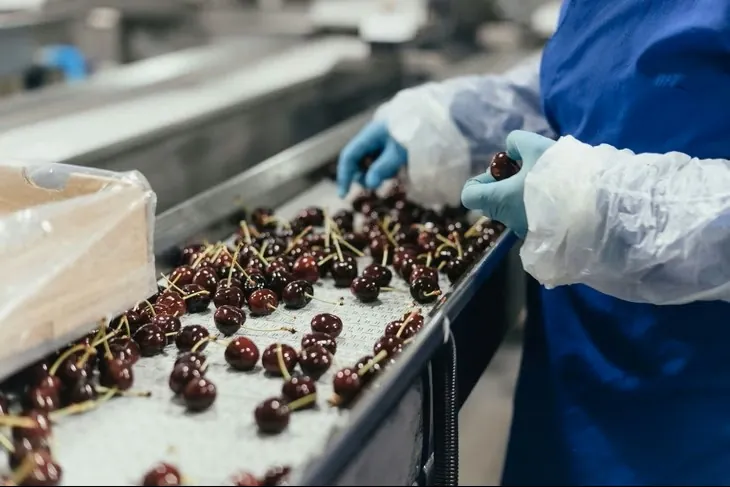In a scenario where cherry post-harvest requires continuous improvement, we often wonder what to do and how to do it. Faced with the need for precise answers and actions, in this article, we address these questions by providing clear guidelines and sharing the results of a decade of research.
The results of our research have been disseminated in various countries, from Chile to Peru, from Argentina to the United States, providing recommendations and strategies that have significantly improved the conditions of destination fruit.
The key lies in what we have defined as the "moisture chain." This approach identifies post-harvest as a sequential process composed of several phases, each with specific environmental conditions. By understanding and characterizing these phases, we can take concrete measures to control dehydration and fruit metabolism.
From harvesting to fruit arrival, the cherry post-harvest process includes six crucial phases: harvesting, on-field collection center, ground transport to the processing plant, plant reception, raw material storage, and sea transport.
By analyzing each of these, we can identify problems and apply specific solutions to improve fruit conditions at their final destination, especially in markets like China, where demand is high and quality is a determining factor.
One of the main challenges cherries face during the journey to the export destination is dehydration, resulting in loss of texture and stem browning, characteristics highly appreciated by Asian consumers. Additionally, fruit metabolism accelerates its ripening, deteriorating the fruit's final conditions.
The moisture chain offers concrete solutions to address these challenges, focusing on controlling pulp temperature, ambient temperature, relative humidity, and processing time. These variables are key to ensuring cherry freshness and extending shelf life.
Effective implementation of this chain requires accurate measurements. This entails using tools such as stem thermometers and thermo-hygrometers to obtain objective data and move away from qualitative assessments.
Dehydration results from water loss in the form of vapor, which can be controlled by modifying the vapor pressure deficit (VPD) in the environment. Lowering the temperature or increasing relative humidity are effective strategies to maintain a low VPD, ideally kept below 0.5 kPa throughout all post-harvest process phases.
Metabolic activity also plays a crucial role in fruit deterioration. Hence, it's widely known that fruits need to undergo a cooling process during post-harvest, maintaining a temperature of 0°C during transport to the export destination.
However, this doesn't imply temperature can be overlooked during pre-cooling stages when fruits are still in field conditions. During these stages, it's essential to keep cherry pulp temperature below 20°C (see Figure 1) to slow down the deterioration process, as both solar radiation and cellular respiration can raise fruit temperature.
Implementing preventive measures like shading and choosing the right time for harvest is indispensable to control this effect.
Once problems are identified, damages assessed, and possible solutions defined, it's crucial to identify critical points of the process. These are where issues are most complex or of greater magnitude, allowing prioritization of solutions.
Initially, it's important to note that 93% of cherry dehydration occurs while the fruit is still in Chile, while only the remaining 7% happens during the journey to the final destination. This highlights the need to focus on process phases preceding shipment. Through specific measurements, critical phases requiring further attention can be identified.
Below are recommendations for each post-harvest phase, which will help mitigate the effect of dehydration and metabolism on cherry final conditions.
1 - Harvesting
- Harvest at the right ripeness. The later the stage of fruit harvested ripeness, the faster the senescence will be.
- Start harvesting at 6:00 in the morning. Natural light is adequate, and environmental conditions minimize dehydration, with a VPD close to zero and low temperatures that do not damage the fruits.
- Deploy crates along the row to reduce the distance pickers have to travel, thus optimizing harvesting time.
- Harvest team formation and distribution should aim to fill a crate within a maximum of 30 minutes.
- Assign one supervisor for every 12 pickers to ensure effective supervision and immediate correction of incorrect practices.
- Install a double Raschel net on each crate during filling to avoid sun exposure and pulp temperature increase.
- Cover containers with wet sponges to maintain humidity and avoid direct sun radiation on cherries.
- Waiting time for containers before transfer to the collection center should not exceed 10 minutes.
- Conduct daily evaluation meetings including analysis of plant reception reports to continuously improve the harvesting process.
2 - On-field Collection Center
- While awaiting transportation to the processing plant, fruits must be stored in a storage center equipped with a humidification system and designed to preserve internal humidity.
- It's crucial to maintain humidity within the storage center in a range between 85% and 95%, which will help minimize dehydration by keeping both room temperature and pulp temperature at around 20°C.
- A collection center with a humidification system also serves as a contingency measure, safeguarding the fruit in case of transportation setbacks to the processing plant, such as truck delays, delays in transit from the field to the plant, or congestion at the processing plant reception. Faced with potential adverse scenarios, it's preferable to store the fruits in this collection center to minimize their deterioration. In fact, in a humidified storage, a cherry takes 25 hours to dehydrate, as if it had been left outdoors for only 1 hour.
3 - Transportation from the Field to the Processing Plant
The refrigerated truck is the optimal transportation system. For field-temperature fruits, a transportation temperature of 15°C is recommended, while for previously hydro-cooled fruits, a transportation temperature of 5°C is suggested. This transportation method ensures control of pulp temperature at adequate levels, protects fruits from wind exposure, maintains a low VPD to minimize moisture loss, and optimizes logistics due to increased loading capacity.
4 - Product Reception at the Processing Plant
Most cherries arrive at the processing plant between 3:00 PM and 7:00 PM, generating significant concentration and subsequent congestion due to truck waiting for unloading and the bottleneck represented by passage through the "hydrocooler". This wait, which sometimes can last up to 4 hours, requires emergency measures.
The damage caused by this delay in unfavorable conditions can be mitigated by implementing humidification systems in the reception areas of processing plants, providing the fruit with a minimally dehydrating and temperature-controlled environment.
5 - Raw Material Storage (Awaiting Processing)
After undergoing the hydrocooling process, cherries are stored in cold rooms, where they wait to enter the processing. During this waiting period, which can last from a few hours to several days, the residual water in the hydrocooler acts as a protective shield against cherry dehydration.
However, as this water reserve depletes, cherries are exposed to increasing levels of dehydration. Implementing humidification systems in raw material storage rooms will provide stored fruits with an environment with a lower VPD, effectively protecting them from dehydration.
6 - Sea Transport
The use of modified atmosphere bags and the optimization of transport times, through initiatives such as the "Cherry Express," have had a significant impact on reducing cherry dehydration in the final post-harvest phase. This is reflected in the fact that only 7% of the total dehydration occurs in this phase, while the remaining 93% occurs before shipment.
Furthermore, it has been demonstrated that managing the moisture chain during the post-harvest process also influences this final phase. It has been observed that cherries treated according to moisture chain principles tend to dehydrate less during transport to the final destination compared to those where moisture is neglected in the process.
In conclusion, it's essential to understand the operation of the above-described humidification systems in the various stages of the cherry post-harvest moisture chain, which are responsible for significant benefits.
This technology releases water micro-droplets that, in high-temperature environments, transition from liquid to gas state, absorbing energy from the environment and thus reducing the temperature. Our studies have shown that a good humidification system can reduce air temperature by over 10°C through this evaporative cooling process.
Decreasing ambient temperature also has a positive impact on fruit pulp temperature: in a properly humidified collection center, it's possible to reduce pulp temperature from 30°C (initial temperature) to 20°C in just one hour. Additionally, a significant portion of the micro-droplets dispersed by the humidification system remains suspended in the air in liquid form, creating a mist or fog that increases the relative humidity of the environment to over 90%.
The moisture chain represents a revolution in cherry post-harvest. With the gradual approach we have shared, significant reduction in fruit dehydration and deterioration can be achieved, ensuring optimal conditions at the destination. With concrete strategies and precise measures, we can achieve new standards of excellence in this vital process for the fruit industry.
Source: Redagrícola
Image: Jill Wellington
Cherry Times - All rights reserved











